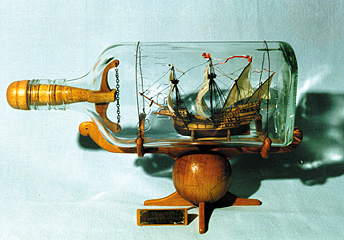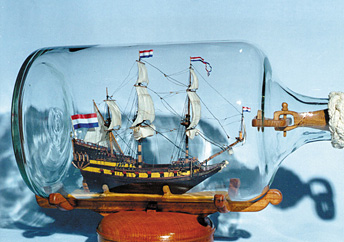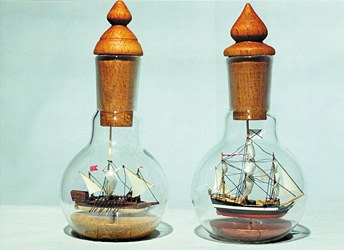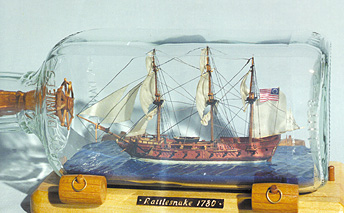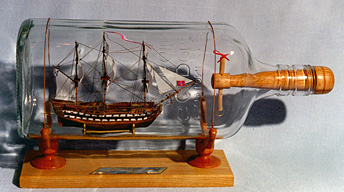Ships In Bottles
It is not a secret that mankind history inseparably connected with the sea. Since ancient times people overcoming fear have traveled across the seas and oceans. They were lead by insuperable thirst of adventures in search of the new. Nowadays we admire them, reading stories about the great geographical discoveries, brave seamen and pirates. What a courage a person should have to go to a storming ocean on a fragile little craft subjected to impacts of nature. And, of course, such a sailing cannot be compared with traveling in a cozy cabin of a modern super liner.
Not very many people know that ship modeling is a very old art. Archeologists found models of primitive boats even on a site of an ancient civilization, they were children's toys. Models of vessels also were used for various worships — they were put in tombs to make the transition of a dead person into another world easier. Fine gold and silver ship models were found in Mesopotamia and the Egyptian Valley of The Kings. In general, the history of ship modeling totals not one thousand years.
Speaking about ships in bottles, this art is considered to appear in Europe in 17-18 centuries. The models that can be found in some European museums can be dated to those times. Seamen whiled away the time on the shore drinking alcohol from bottles and therefore one of them had an idea to put a small ship inside one. Could have ship models appeared before the mentioned times ? Most researches thought it was impossible as ancient glassblowers were not able to make transparent glass to easily see the contents. Anyone could hardly want to put models into lightproof bottles. However some new data show the opposite: we can see transparent glasses and vessels on old paintings. Is it a master’s fantasy or a reflection of reality? Archeologists found fragments of broken glass more often which age is thousands if years. In old times glass was very expensive and difficult for poor people to buy. Yet we can not exclude the possibility that a talented master could put a ship model inside any of those bottles.
Besides ships masters created religious scenes, scenes from everyday life, various mechanisms and other things. This kind of art might have appeared earlier than ships in bottles. But the term “ships in bottles” should include everything that can be created in a bottle through its narrow bottleneck.
As a rule, models in bottles are divided into 3 principal groups:
Ships in bottles
There is just a ship model in the bottle. Attention in such models is paid to accurate reproduction of the details. The model inside the bottle can lie on a special stand or glide on the sea surface made by a/the master.
Diorama
Dioramas show scenes from life, often nautical. It can be a huge port with a big city on the shore and ships in the roads, sea battles, a sinking vessel and others.
Unusual things
This group covers everything that a master’s rich imagination can create. It can be religious scenes, mills, mechanisms, statuettes, cars, planes, that is all that can not be named “a ship”.
In spite of industry developing ship models are still handmade and they still amaze us; besides it is an art that requires much patience and skill. Many people are fond of ship modeling nowadays using modern materials and constantly inventing new methods of fitting.
In such countries as England, Germany, Holland, Denmark, Norway, France, Japan, USA and some other there are associations that unite people interested in ship modeling. There exists even the European Association of Ships in Bottles with members from all over the world. These organizations publish magazines, arrange exhibitions and conferences making the life of its members more interesting. There are also a lot of museums where you can see ships in bottles.
This book is probably the first one to reveal the secrets of creating ships in bottles. You will find an answer to that torturing question “How?” The book tells you about various methods of fitting, gives you recommendations about making small details of a ship and reveals the secrets of cork puzzles. A great number of pictures and illustrations will help you to get a deeper understanding of the process. This book will be interesting for both beginners and experienced masters and everybody will find something interesting in it.
Table of contents:
- Ships in bottles. How to put a ship into a bottle?
- Method 1. Traditional.
- Method 2. Straws
- Method 3. Without a joint
- Method 4. A Joke?
- Method 5. Great potential
- Instruments
- Handy hints and tips for boat model makers
- Incredible Corks
- Unusual ship models in bottles.
- Stands, drawing and bottles
